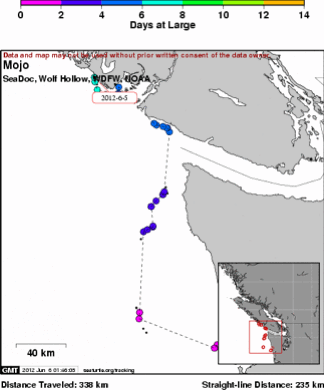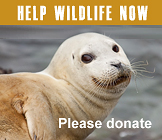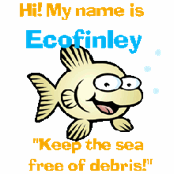Jun 2012
Lazy afternoon for an urban seal
Jun/30/12 09:13 PM
Earlier, along Alki Beach, a smaller seal was seen following a paddle boarder very close to the beach. After the boarder landed, the curious weaner spy-hopped offshore for a bit and it appeared he might haul out - even with people nearby. However, he apparently had second thoughts and vanished with a silvery flash beneath the gray sheen of Puget Sound.
Seal pup births in South Puget Sound - season officially underway
Jun/28/12 06:00 PM
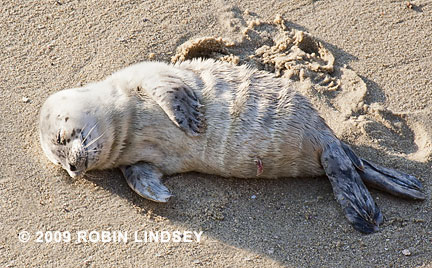
There was also a report of a partial lanugo pup on the beach in Edmonds. A lanugo coat, long and fluffy white fur, is usually shed in the womb of the mother seal. Sometimes, though, when a pup is born a bit prematurely, the coat will still be on the newborn. This coat is quickly shed and replaced by a new coat. Sadly, a lanugo pup has less chance of survival than a full-term pup. A pup’s best chance is with an attentive mom, nursing on her rich (50% fat) milk. If you come upon a seal pup, please stay back and notify the stranding network. Most likely mom is around, but volunteers will monitor the pup and keep him safe from people and dogs.
Make sure you check the blog frequently for “pupdates”. News on the beach should start picking up soon, after a welcome break from our very busy off-season with many weaned pups sticking around West Seattle. Seal Sitters will be assimilating new volunteers during the season by offering a few smaller scale training sessions, on the beach and in meet-ups. If you are interested in volunteering, please email us.
Quiet on the beaches, but not for long
Jun/17/12 08:12 PM
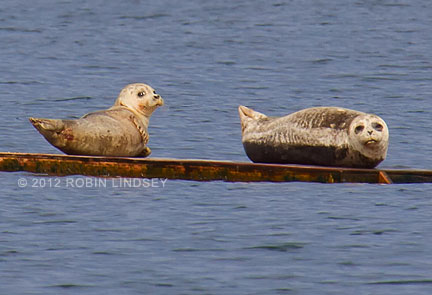
Pupping season is just now underway in South Puget Sound harbor seal rookeries. Soon lots of fat little “blubberballs” will be headed our way, following small bait fish, and needing to rest on very urban shores. It is always an exciting time of year for our volunteers, local residents and visitors who come as far away as Russia and France to enjoy a stroll along West Seattle’s shoreline.
Since spring of last year, we have distributed close to 7500 business card-sized “Share the Shore” brochures, containing information about seal behavior, species identification, the NW Stranding Network and protocol if you encounter a pup (or any marine mammal) on the beach. Norberg Press, a West Seattle printing firm, has generously donated another 10,000 brochures for our outreach this year. Many, many thanks to Rick of Norberg for this invaluable contribution! Please visit Norberg Press for your printing needs.
On a sadder note, we have had several pinniped deaths in the past week or so. A dead pup at Lincoln Park was transported to WDFW Marine Mammal Investigations Unit with a severe chest wound. The biologist believes the most likely cause was from a boat propeller. An adult harbor seal will be necropsied tomorrow morning and a sea lion was found dead on the Elliott Bay side of West Seattle. We will keep you updated on any necropsy findings of interest.
Schmitz Park Elementary kids help marine mammals - again!
Jun/17/12 08:00 PM
Seal Sitters has received word that we are the recipients of a generous Penny Harvest grant from the amazing kids at West Seattle’s Schmitz Park Elementary school. The children collected pennies from friends, neighbors and businesses to raise funds for local non-profits who do work in the community. This is the second year that these caring young philanthropists have helped defray our operating costs, most especially that of our dedicated phone hotline. Flipper hugs to the students and teachers - Schmitz Park rocks!
Mojo the sea lion an international traveler
Jun/07/12 08:26 AM
Mojo, the Steller sea lion pup released on the outer coast of Washington last week, quickly made his way north and has settled into Canadian waters. The most recent satellite hits place him near Tofino on Vancouver Island. The Tofino/Ucleulet area is known for large concentrations of Stellers, a threatened species. In only 7 days, he has travelled 310 km (192 miles). Mojo would have most likely been born in a Steller sea lion rookery located in Oregon or Alaska. Since he was at least 6 months old when rescued from Pacific Beach in Washington, it is conceivable that he spent time in Canada with his mom. Or perhaps he hooked up with another Steller in Washington who was headed north. We will never know why he chose to travel to Canada, but are relieved that he has found members of his own species to hang out with - and in a much safer territory than around the Columbia River at Oregon and Washington’s border, where up to 20 sea lions have been shot (see related story).
Follow Mojo’s travels on SeaDoc Society’s website.
Follow Mojo’s travels on SeaDoc Society’s website.
Mojo the Steller sea lion pup returned to the wild
Jun/01/12 08:22 AM
On February 16, 2012 WDFW Marine Mammal Investigations responded to a Steller sea lion pup at Pacific Beach. This is believed to be the same Steller pup that was reported numerous times in other locations over a two week period with sightings on the Long Beach Peninsula and in Ocean Shores. The pup was weak, dehydrated, emaciated, and appeared to be separated from his mother. The pup, named Mojo, was transferred the following morning to Wolf Hollow Rehabilitation Center for stabilization, treatment, and care. When he arrived at Wolf Hollow he weighed in at 80 lbs and within the first ten days he gained 11 lbs. After three and a half months of rehabilitation, Mojo weighed in at over 255 lbs., and was strong, healthy, and ready for release. He was to be fitted with a satellite transmitter that is glued to his pelt; this is a non-invasive procedure that does not harm the animal. When Mojo molts, the tag will fall off. However, we expect to receive data regarding his movements and foraging patterns for the next 3-5 months.
Mojo’s Release Day
At 4am on May 29, Seal Sitters’ lead investigator Robin Lindsey rendezvoused with WDFW-MMI biologist Dyanna Lambourn and her dedicated intern Erin D’Agnese for the trip up to Anacortes to catch the San Juan Island ferry. From the boat, as we approached Friday Harbor, we spied a pod of white-sided dolphins. Upon arrival at Wolf Hollow, the team discussed the game plan to sedate and transport Mojo on his long journey back home to the Washington coast, where he was rescued months before. Mojo, expecting his fish breakfast, instead was sedated, examined and fitted with flipper tags for identification purposes and a satellite tag.
The team eagerly carried the snoozing Mojo to the huge cage on the back of WDFW’s pickup. It was still a long day ahead for Mojo and WDFW who would transport him all the way out to the ocean. Within a few minutes, Mojo began to stir in the cage, sporting his fancy satellite hat. As the truck travelled along the highway, he looked curiously out at the moving landscape. We had many, many hours to go. Dyanna’s phone rang and it was a biologist from the outer coast, reporting a live sea otter who had been on the beach since late the day before. Numerous phone calls later, the logistics of getting the animal, suffering from seizures, to US Fish and Wildlife in Olympia were arranged. Dyanna would swing by on our way south to quickly assess and make a determination of the animal, most likely suffering from protozoal encephalitis. Another call came in about a dead harbor seal pup on the outer coast. We would pick the pup up for necropsy after releasing Mojo. The phone rang again - there was a harbor seal pup resting on the beach near our destination. This was just a glimpse into the demanding 24/7 daily life of this WDFW marine mammal biologist and the interns who not only juggle school and jobs, but devote countless hours volunteering for Fish and Wildlife.
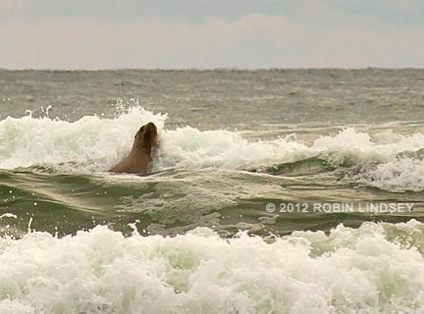
Following Mojo’s release, we scoured the beach south along the ocean for the seal pup reported earlier in the day. This is harbor seal pupping season along the outer coast, and pups use beaches that vehicles are allowed to drive upon. Last year, a pup was run over on the Fourth of July. We could not find the pup, but did find stakes and “Protected Marine Mammal” tape and headed to the highway. Arriving bleary-eyed back at our respective homes around midnight, it was an exhausting, but incredibly exhilarating day.
Mojo will provide invaluable data to the network. Sign up here for email updates showing a map of his travels. This case has been made possible, in large part, through the John H. Prescott Marine Mammal Rescue Assistance Grant Program. Tracking this animal would not be possible without the collaboration of several network groups which include: Washington Department of Fish and Wildlife Marine Mammal Investigations, Wolf Hollow Rehabilitation Center, SeaDoc Society, and NOAA's Protected Resources Division.
